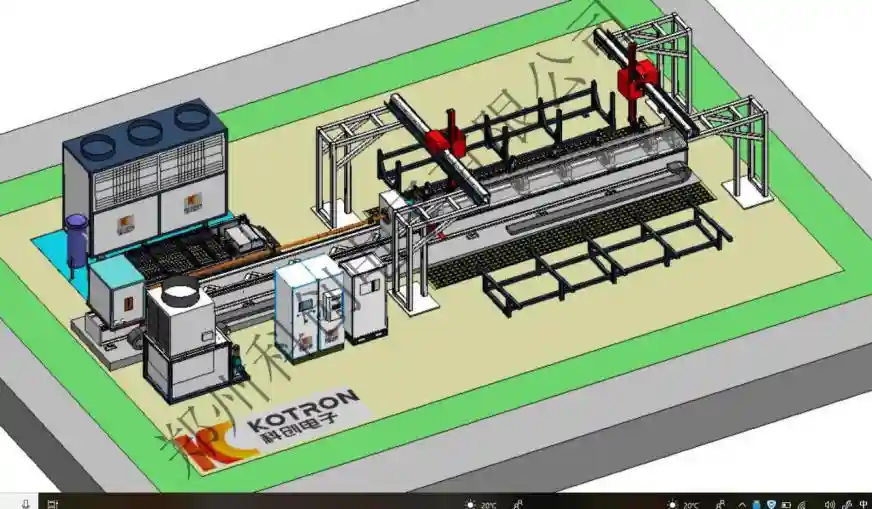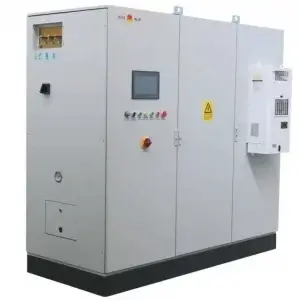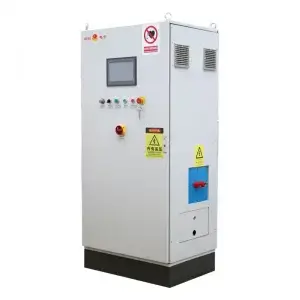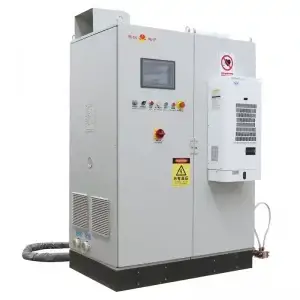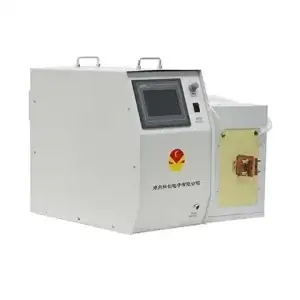Automatic Concrete Pump Pipe Induction Quenching System
The Concrete Pump Pipe Automatic Induction Quenching System is a complete set of equipment specially designed to enhance the wear resistance of the inner and outer walls of pump pipes. Through induction quenching, a high-hardness layer (HRC 55-62) is formed on the pipe surface, significantly extending the service life (3-5 times that of ordinary pipes). The following details the core components, technical features, and selection guidelines of the production line:
I. Core Components of the Production Line
| Module | Functional Description |
|---|---|
| Induction Heating Power Supply | Medium-frequency/ultra-audio frequency power supply (IGBT), power 200-800kW, frequency 1-30kHz, suitable for pump pipes with a diameter of Φ80-300mm and length ≤12m. |
| Quenching Machine Tool | Horizontal or vertical structure, integrated with pump pipe rotation drive (10-60rpm), inductor axial movement (speed 0.1-5mm/s), and simultaneous spraying systems for inner/outer walls. |
| Automated Conveyor System | Roller conveyor + robotic arm for loading/unloading, supporting automatic centering, positioning (accuracy ±1mm), and sorting of non-conforming products. |
| Cooling and Tempering System | Closed-loop water cooling unit (quenching liquid temperature controlled at 20-40℃), optional induction tempering station for integrated quenching-tempering processes. |
| Intelligent Control System | PLC system supporting automatic adjustment of process parameters (power, frequency, movement speed), with real-time monitoring of temperature fields and hardness distribution. |
II. Technical Features and Advantages
-
High-Efficiency Fully Automatic Production
Continuous Operation Capability:
The production line supports 24-hour continuous operation, with a single pump pipe (Φ125mm×6m) processed in 8-15 minutes and a daily output of 100-200 pipes.
Multi-Specification Compatibility:
By replacing inductor kits and adjusting parameters, it adapts to pump pipes of Φ80-300mm, with a model changeover time ≤20 minutes. -
Precision Quenching Control
Dual-Frequency Heating Technology:
Medium frequency (1-10kHz) is used for deep heating (wall thickness 8-15mm), while ultra-audio frequency (10-30kHz) achieves rapid surface austenitization, with adjustable hardened layer depth of 2-5mm.
Simultaneous Inner/Outer Wall Treatment:
A split inductor design—insertion coils for inner walls and ring coils for outer walls—ensures simultaneous quenching and reduces thermal deformation (straightness ≤1mm/m). -
High-Reliability Design
Redundant Cooling System:
Dual pump sets + backup power supply ensure continuous quenching liquid supply (flow rate ≥50m³/h) to prevent production interruptions.
III. Typical Technical Parameters
| Project | Parameter Range | Application Scenarios |
|---|---|---|
| Power Supply Power | 300-600kW (medium frequency), 200-400kW (ultra-audio frequency) | Concrete pump boom pipes, trailer pump pipes |
| Frequency Range | 1-30kHz (programmable switching) | Wall thickness 8-25mm, hardened layer 2-5mm |
| Processed Pipe Diameter | Φ80-300mm, length ≤12m | Concrete mixing plants, pump pipe manufacturers, mining pipeline repair |
| Hardness Uniformity | ≤±2 HRC | High-wear scenarios (pumping C50+ concrete) |
| Energy Consumption Index | 150-300 kWh/ton (depending on wall thickness) | Production lines with annual output of 50,000-100,000 pipes |
V. Selection and Usage Recommendations
-
Process Requirement Analysis:
- Pump pipe materials (45Mn2, 27SiMn, etc.), wall thickness (8-25mm), and hardened layer depth (2-5mm).
- Production scale: continuous batch production vs. small-batch multi-specification production.
-
Key Configuration Priorities:
- Dual-Frequency Power Supply: Adapts to quenching requirements for different wall thicknesses, enhancing process flexibility.
- Rapid Model Changeover System: Electric inductor positioning + parameter pre-storage to reduce changeover time.
-
Maintenance and Cost Control:
- Daily inspection of quenching liquid concentration (controlled by refractometer), monthly cleaning of inductor oxide layers.
- Use domestic wear-resistant alloy magnetic conductors to reduce inductor replacement costs (1/3 the price of imported components).
Grammar and Format Notes:
- Standardized technical terms (e.g., “dual-frequency heating,” “split inductor”) for industry accuracy.
- Maintained logical hierarchy with clear section numbering and table structures.
- Optimized sentence flow for readability while preserving technical details.

